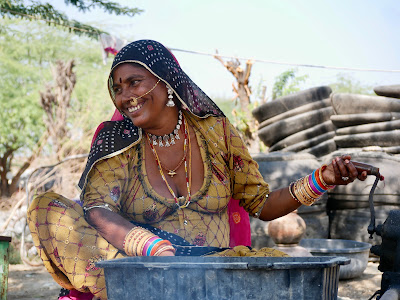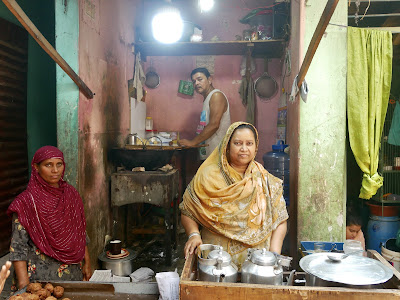My first encounter with the Gadia Lohar was short and unexpected. On the road from Delhi to Churu in Rajasthan, camera in hand, I got out of the car, to stretch my legs. A man working at the side of the road jumped up and ran towards me, shrieking, whooping and shaking his ample belly from side to side. My driver, Naresh, horrified, told me to get back into the car. It was my first time in India, so I did as I was told and we drove off. “What was that about,” I asked him. He replied, “He has some problem sir,” and left it at that. He later explained that the man was a Gadia Lohar, a nomadic blacksmith. Lohar is the Hindi word for blacksmith, and gadia means cart - their means of travel, and their home while on the road.
 |
| Gadia Lohar woman winding the bellows, Pachewar |
The five vows of the Gadia Lohar
Until 1568, the Gadia Lohar were a settled people, producing weapons for the Maharana of Mewar's army. In that year, Maharana Pratap Singh was defeated by the invading Mughals at the Battle of Chittorgarh and was forced to flee. In a show of loyalty, the Gadia Lohar also left, vowing not to return until Chittorgarh was retaken. They also vowed not to live in a house, sleep in a bed or draw water from a well and began to live the life of itinerant workers. Pratap Singh never did retake the city and they remained nomadic, traveling from place to place on their bullock carts in search of work. In 1955, Pandit Nehru visited Chittorgarh and in a filmed ceremony, released them from their vows. Despite this, many Gadia Lohar are still not settled and live in makeshift camps, at risk of being moved on with little or no notice.
Rajasthan has many diversions and I forgot about the man at the side of the road, until during one of the covid lockdowns, I discovered the Netflix documentary India's Forgotten People. Deana Uppal, a reality TV contestant turned actress and filmmaker, curious about the Gadia Lohar, befriended a group camped near Jaipur. Her film shows their problems, traditions and way of life. It also exemplifies the widespread discrimination they face. In Jaipur, when she asks about meeting them, she is warned that the Gadia Lohar are dangerous criminals and should be avoided. She later discusses their plight with officials, who although polite, fail to address any of the issues she raises with them.
"It is hard to make a living from this work"
More recently, I met Gadia Lohar communities in Rajasthan, in Deboli and near Pachewar. The Deboli group were camped on rough ground in the centre of the city. A couple were working at the entrance to the camp, the woman winding the bellows while her husband did the hot work, heating the metal. They then worked together, wielding hammers to mould the red-hot items into shape. They toiled without protective gear, in thirty-five degrees of heat, inhaling the thick smoke from their small furnace. They make tools, knives and other kitchen implements for sale in the street, but cannot compete with the cheap, mass produced items available in the markets. An elderly man, one half of a married couple who came to speak to me said, "We are skilled but these days it is hard to make a living from this work. Our ancestors produced weapons but today people don't want the things we make."
 |
| He put on his best turban for a photograph, Deboli |
The Deboli group had an additional problem. They claim to have lived in this location for many years but admitted that it is an unofficial settlement. The authorities want to develop the site and have told them to leave. He also said, "Some people have already gone to the new place, but it is not big enough for all of us and there is not enough money to build houses for everyone." Those that remained were living in tents, some large enough to accommodate an extended family and their cart. One resident proudly showed me his family's gadia, “It is fifty years old,” he said as he pointed out the brightly coloured, hand-painted decorative patterns on its sides.
Before I left, I photographed the elderly man and his wife, but not before, at his insistence, he put on his best turban, replacing the gamcha (workers' scarf) he had been wearing when I arrived. His wife pulled her dupatta (scarf used to cover head and shoulders) further forward on her forehead and pointed out her bhanvaria (nose ring) and tattooed earlobes to me. Once ready they stood side by side, very formal, him extremely tall and her, petite. I also took individual portraits of them.
 |
| Gadia Lohar woman in Deboli, wearing the bhanvaria (nose ring) and traditional jewellery |
"This peacock tattoo will take me to heaven"
I met Shankar Gadhia Lohar at a tea stall in Pachewar, a village of about nine thousand people, one hundred kilometres from Jaipur. He invited me to his settlement where he lives with his extended family, just a few kilometres away. Shankar makes kitchen utensils and small ornamental items which he then sells at the side of the road. I bought a colander from him for 50 rupees (about 50 pence), which came in useful when I visited a Bhand community on the opposite side of the road.
Shankar is not the only craftsman in the family. His older brother, Hanuman, is an accomplished metalworker whose work has attracted awards and media attention. He has a workshop on Pachewar's main street where visitors are offered tea and snacks, but where there was no pressure to buy. His wife and daughter-in-law work with him and at the time of my visit, his children were quietly doing their homework after school. Hanuman concentrates on producing art works and I came away with two small pieces - a camel and a snake.
One of the older women in the settlement had facial tattoos. I asked if they had a meaning. "No, no, they are just for fashion," said one of the younger men. On hearing this, the woman, who until that point had been silent, became very animated and contradicted him. "They protect us against misfortune," she said, "and this peacock tattoo will take me to heaven." She also explained that the jewellery Gadhia Lohar women wear, acts as a deterrent to the evil eye. When she finished speaking, Shankar introduced her to me as his mother.
 |
| Hanuman, Gadia Lohar artisan, Pachewar |
"I used to work as a day labourer to pay for my schooling"
While Shankar's mother was speaking, Sangram Singh Gadia Lohar arrived. We drank tea together and he spoke about his efforts to secure educational opportunities for his community. He said, “I used to work as a day labourer to pay for my schooling. I completed higher secondary education and then worked for an organisation that trains people in community development. I started an open-air school for our children, but it is difficult to get regular attendance as most of the parents are uneducated and do not understand why school is important.” He also spoke about the difficulties of finding somewhere to settle, and said, “I have worked very hard to persuade the authorities to give small parcels of land so that we can build our own houses. The problem is that although we are told we can build on the land, we do not receive documentation. This means we can be moved on at short notice.”
Sangram said, “Our traditional way of life is no longer sustainable. The young people need to be educated, to develop new skills, or to adapt our traditional craft in the way Hanuman and Shankar have.” While he was speaking a small boy came out of one of the tents. After playing with a tyre for a few minutes, he opened his father’s toolbox, took out a hammer and began hitting a charpoy (day bed), imitating the adults working nearby. I asked his father if the boy will go to school. He smiled and said, “I don’t know.”
 |
| "Will he go to school?" I asked. |
You might also like "What have you brought me?" - an encounter with the Band in Rajasthan


























